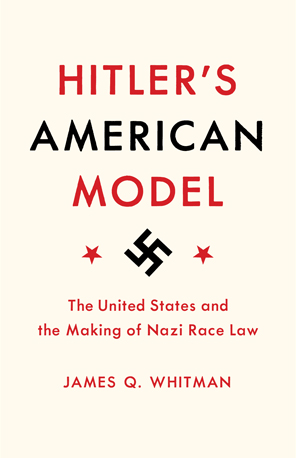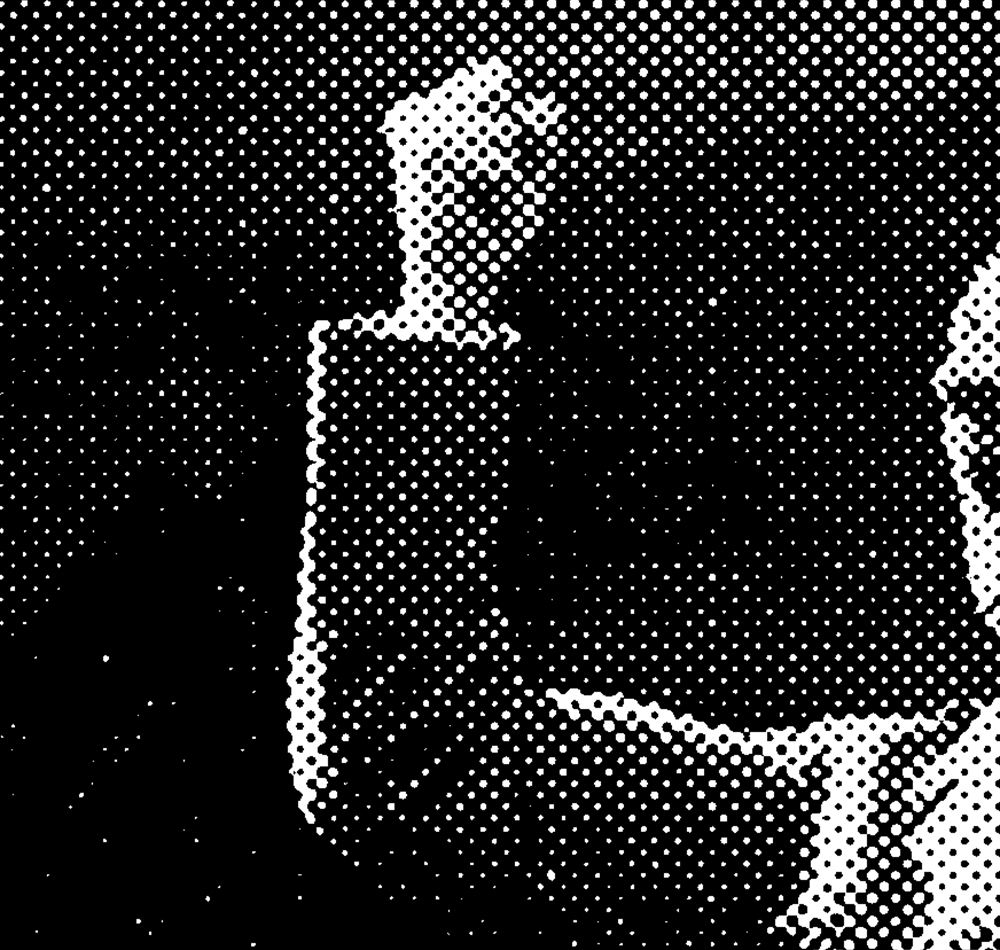Amidst a string of pat introductory reflections to his recent book, Hitler’s American Model, which tracks the influence of American race law on the drafting of the Nazi Nuremberg Laws, James Q. Whitman makes one that is revealing. The crimes of the Nazis, he writes, are the “nefandum,” a Latin word that denotes the unsayable, by which he means unfathomably evil. According to Whitman, the function of this unsayability is the maintenance of a “dark star”—his image, not mine—against which modern liberal democracies orient their own actions and histories. The point of Hitler’s American Model, then, is to bring the very often spoken horrors of the Holocaust—in this case the legal apparatus that enabled a genocidal state—into contact with the also unsayable, and surely less said, international influence of United States race laws.

James Q. Whitman, Hitler’s American Model: The United States and the Making of Nazi Race Law. Princeton University Press, 2017. 224 Pages.
Comparisons of things that aren’t fascist dictators to fascist dictators are made as commonly as they are condemned. When it comes to comparing people to Hitler, there is a rule of internet discourse that strongly discourages it. In liberal media outlets, with pseudo-earnest concern—Is Trump like Hitler?—the comparison is both energizing and reassuring: energizing because it denotes the clear radicality of Nazi evil, comforting because of the implicit anticipation of the triumph of liberal norms. The impulse to make the Nazi comparison is so common in part because it is understood almost invariably to be hyperbolic. (No, or at least not yet, is the most frequent response.) What is less common are claims to the messier truth of continuity, which fail to offer the sharp and spectacular relief that separates the horrors of the Nazi regime from the more common pace and texture of devastation by state violence. On one side of the comparison is generational immiseration, imprisonment, exile and death tempered by civility; on the other, the right-angled arm-band and the death camp.
Whitman’s history of influence contributes to a growing body of work that demonstrates links between America and Nazi ideology: most commonly cited are the prominent role of Americans in the global eugenics movement and Hitler’s admiration for the slaughter of indigenous people central to westward expansion. Before the Nazis had gripped complete control of Germany, America was receiving world-historical praise from German historians. Albrecht Writh, for example, understood the founding of the United States to be a key achievement in “the struggle of the Aryans for world domination”; in a volume titled The Supremacy of the White Race, Wahrhold Drascher wrote that, if not for America, “a conscious unity of the white race would have never emerged.”
In Mein Kampf, Hitler extended this praise to his present, pointing with admiration to American naturalization and immigration laws. As he railed against the loose strictures delimiting German citizenship, the United States appealed to Hitler as a state with a "better conception" of membership restrictions. His commentary was made in the wake of the Immigration Act of 1924, which, along with its legislative precursors in the 1882 Chinese Exclusion Act and the 1917 Asiatic Barred Zone, introduced sweeping "national origins" restrictions on immigration, excluding people from large swathes of Asia and the Middle East wholesale while placing severe quota restrictions on not-yet-white southern Europe. Hitler—correctly, it would seem—read such laws as confirmation that American legislators were acting against the image of the state as a “melting pot”—eliminating, as he put it, the “Völker-porridge” theory of the state by expelling “foreign bodies.”
By 1933, praise had become doctrine. The Nazi Handbook for Law and Legislation, a guiding Party document for lawmakers, fused the misty-eyed conception of America as a white supremacist zenith with its study of contemporaneous immigration policy, and concluded that, from America’s “fundamental recognition” of its white racial identity, it was only “a matter of logical thinking” to arrive at the political ideology of National Socialism.
Citizenship, depending on the context, is either a dog whistle or a foghorn. Inspired by America’s explicitly race-based immigration policy and the category of “non-citizen nationals”—created to class the subjects of Puerto Rico and the Philippines, territories seized by the newly imperial US—the first of the two Nuremberg Laws explicitly fused race and citizenship. Because the law defined a citizen as one with German or related blood, it stripped Jews of the protections of citizenship, leaving them with a legal status that could be broadly illustrated with the words used by the Supreme Court to describe colonial subjects of the US: “foreign … in a domestic sense.” A year after the passing of the Nuremberg Laws, a Nazi scholar noted the similarities between America’s tri-tiered citizenship schema and the hierarchy suggested by Hitler in Mein Kampf: citizen, national, alien.
The initial aim of the Nazi’s racist legal order, Whitman reminds us, was not the extermination of the Jews—formally decided upon in 1944—but the “emigration of the Jews out of Germany.” The Nazis recognized the use of American immigration law as a tool of ethnic cleansing and demographic protectionism, one that could be mobilized alongside the use of propaganda, permissible street violence, and the degradation of legal status. In Party newsletters, Nazi writers identified this diversity of tactics as comparable to the range of measures—legal and otherwise—that had been taken throughout the US to immiserate Black people. In a report on de facto segregation in New York City, for example, Black people were portrayed as a demographic threat to white society. In line with the frequent use of nonwhite children as both synecdochal manifestations of this threat and the threat itself, the magazine featured an image of two young boys in Harlem, captioned “The Negroes are multiplying significantly… Their constantly growing numbers are a source of great concern to American statesmen.” Hitler, in Mein Kampf, wrote with worried irritation that “any Jewish child, or Polish child, or African child, or Asian child” might become a citizen of Germany through naturalization.
In the same article, the authors posed a question: “What is lynch justice, if not the natural resistance of the Volk to an alien race that is attempting to gain the upper hand?” Alongside the pogrom-like violence being carried out against Jews in the streets of Germany, Nazi legal scholars and propagandists alike understood lynchings in the American South as part of a shared commitment to defending racial purity—the existential threat to which was often articulated along the sexually maintained border of whiteness. The second of the Nuremberg Laws—the Law for the Protection of German Blood and German Honor—thus bound citizenship to sex, outlawing marriage and intercourse between Jews and Germans.
For this, there was ample American precedent. Whitman reproduces a transcript from the June 1934 meeting of the Commission on Criminal Law Reform, which features a lengthy and eerily dry debate over the criminalization of interracial marriage. The meeting was split between a traditional conservative camp, who argued that it was legally inconsistent to impose criminal consequences on the civil institution of marriage, and more radical Nazis, who countered them with a detailed report on anti-miscegenation statutes across thirty American states. These laws, which variously imposed punitive sentences for marriage between Black and white people, Black and indigenous people, white and indigenous people, and so on, provided a model for criminalizing marriage that could not be found outside the US.
The debate between the two camps is revealing. Traditionalists argued that the vast array of American statutes couldn’t be introduced into the German legal system because the Americans had failed to develop “clear and unambiguous” definitions of the races they were targeting. (The debate over how to legally define a “Jew” was fraught; many Nazis found the American one-drop rule “too harsh” for their program.) But this conceptual messiness appealed to the more extreme Party members: the wide variety of rigorless definitions of racial categories struck Roland Freisler, who would go on to a murderous tenure as president of the Nazi People’s Court, as “targeting a kind of race image.” The political aims superseded any putative commitment to the “scientific” racism that is famously understood to be at the core of Nazi ideology. Freisler argued, counter intuitively, that American race law was “even more explicit” than the Nazis’: the absence of a programmatic campaign with clearly defined racial categories left the unstated political aims of the American legislation—the maintenance of white supremacy—explicit.
If evidence of Nazi adoption of American racism—in the form of eugenics and westward expansion—has already been accepted into the historical canon, what about this regime-to-regime legal interest is surprising? Whitman asks the question himself, noting that the admiring picture the Nazis paint of the US is not “unrecognizable.” The details are both shocking and already-known.
For example, I was surprised, but should not have been, at a passage in Whitman’s book that felt important but was presented as marginal. Colonial administrators in German South West Africa, Whitman explains, had, like the Nazis that followed them, conducted extensive research on anti-miscegenation statutes in the American South. In accordance with their findings, they criminalized interracial marriage in the colony in 1905, thirteen years before the end of the First World War and the economic conditions of possibility for Nazi rule. Evidence like this—of the repetition and refraction of strategies of white supremacist domination across time and continents—seems to be the central truth haunting the background of Whitman’s book. But even armed with the plain facts of the traveling use of anti-miscegenation statutes from New World to African colony to Nazi Germany, framing that continuity as inherent to the governance of colony, fascist state, and "free white men’s democracy" seems to feel or sound too broad for reluctant audiences—as worthy of dismissal as conspiracy theories. (In his conclusion, Whitman clarifies for the reader that he is not an “extremist” who would claim “the United States is the source of all evil in the world.” OK.)
Part of the muted force of Whitman’s book—with its sparse and committedly liberal editorializing—ends up being that he himself appears as an unwilling audience to his own research. Several times the reader finds him repeating variations of the sentiment that his chosen subject matter is “hard to digest,” or “a bit too awful to contemplate.” There is shame in these moments—and what sounds like an anticipation of the charge of an anti-Americanism that would make a balanced equation between the United States and the Third Reich.
Whitman’s defensiveness betrays an awkward nationalism that reads Nazi appreciation for America’s racism as somehow worsening that racism, making it more difficult to digest. As if only through the destabilization of the singular "dark star" of racist state violence can the extremity of American racism be understood with the appropriately indigestible weight. The presentation of continuity disrupts the direction of the Nazi comparison—it goes both ways. The situation suggests that the continuity between horrors is more important and more difficult to see than the discontinuity produced by comparison. What appears to be still difficult, even as it gets told in ever finer detail, is the simple and immense situation that the book demonstrates, that America and Nazi Germany are two instantiations of a history of white supremacist rule—a principle of domination that has been carried by opposing, sometimes warring, regimes. What Whitman does allow, with a brief coda on the criminal justice system, is that what is “too awful to contemplate” is that this history is not yet over. As a Nazi race theorist wrote in 1934, again in the context of praise for America’s stringent immigration laws: “The American [still] knows very well who made his land great.”
